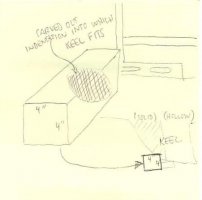I have had some luck raising the bow with a bottle jack (Harbor Freight, so I don't worry if it gets wet/salty) and a 4 x 4 timber with an indentation chopped out of it to match the forward part of the keel. As the boat gets lifted, the timber gets put (ie, pounded) in place. QUOTE]
If you could post a picture, I think it would be worth a thousand words, and exactly what I need, since the E32 and E35 keels look fairly similar.
The yard placed some blocks under the forward and aft ends of my keel, making it level, and therefore the boat point nose down to a huge degree. When they move me out, and I start rebuilding the interior, is when I want to get things level.
My boat is in Brewerton, at the west end of Lake Oneida. After the marina in Pensacola got completely wiped out by Ivan, that was the cheaper of the two places with inside storage I could find (much of my deck was gone, so I had to get out of the weather). Not exactly good times getting there, but hopefully will be better leaving. I am planning on taking the canal to the Hudson, then either up to the St. Lawrence (most likely) or through NYC.
Where did you keep you boat on the west coast, Fiddler's Cove? And where are you now, on the Hudson or LI Sound?
Gareth
Freyja E35 #241 1972

